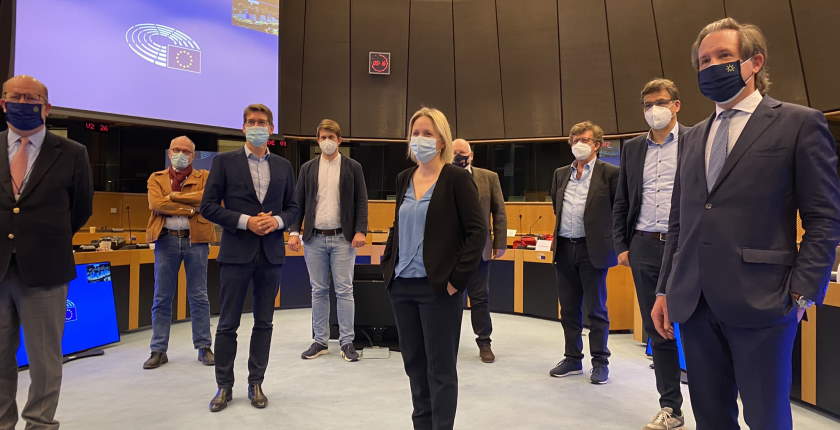
Council's and parliament's negotiators (photo: 2021Portugal.eu/Twitter)
The European Union has agreed to make climate neutrality by 2050 a legally binding target and set a target of reducing net greenhouse gas emissions by at least 55% by 2030 compared to the 1990 levels.
The negotiators of the European Parliament and the European Council have reached a provisional agreement on the European Climate Law. The law is the cornerstone of the European Green Deal which aims for climate neutrality by 2050.
In March last year the European Commission proposed a European Climate Law with the aim of making the EU’s plan to achieve net zero greenhouse gas emissions by 2050 legally binding.
According to the European Council, the negotiators reached a provisional political agreement setting into law the objective of a climate-neutral EU by 2050, and a collective, net greenhouse gas emissions reduction target (emissions after deduction of removals) of at least 55% by 2030 compared to 1990.
The agreement sets a commitment for negative emissions after 2050
The European Parliament has asked for a 60% target, however the agreement also sets an aspirational goal for the EU to strive to achieve negative emissions after 2050.
Regarding the 2030 target, negotiators agreed on the need to give priority to emissions reductions over removals. In order to ensure that sufficient efforts to reduce and prevent emissions are deployed until 2030, they introduced a limit of 225 Mt of CO2 equivalent to the contribution of removals to the net target. They also agreed the EU shall aim to achieve a higher volume of carbon net sink by 2030, the council said.
Other elements of the provisional agreement include:
- the establishment of a European Scientific Advisory Board on Climate Change, composed of 15 senior scientific experts; it will be tasked, among other things, with providing scientific advice and reporting on EU measures, climate targets and indicative greenhouse gas budgets.
- European Commission would propose an intermediate climate target for 2040, if appropriate, at the latest within six months after the first global stocktake carried out under the Paris Agreement.
- European Commission will publish a projected indicative EU’s greenhouse gas budget for the period 2030-2050; the budget is defined as the indicative total volume of net greenhouse gas emissions (expressed as CO2 equivalent and providing separate information on emissions and removals) that are expected to be emitted in that period.
- European Commission would engage with sectors of the economy that choose to prepare indicative voluntary roadmaps towards achieving the EU’s climate neutrality objective by 2050.
The provisional political agreement is subject to approval by the council and the parliament, before going through the formal steps of the adoption procedure.
Everything is set for the Commission to propose its “fit-for-55” climate package in June
João Pedro Matos Fernandes, Minister of Environment and Climate Action of Portugal, which holds the presidency of the European Council, said that the European Climate Law is “the law of laws” that sets the frame for the EU’s climate-related legislation for the 30 years to come. He said that the agreement paves the way for the Commission to propose its “fit-for-55” climate package in June.
“Our political commitment to becoming the first climate neutral continent by 2050 is now also a legal commitment. The Climate Law sets the EU on a green path for a generation. It is our binding pledge to our children and grandchildren,” said Ursula von der Leyen, President of the European Commission.
Ursula von der Leyen: our political commitment is now also a legal commitment
Executive Vice-President for the European Green Deal, Frans Timmermans, added that the Climate Law will shape the EU’s green recovery and ensure a socially just green transition.
“Today’s agreement also reinforces our global position as a leader in tackling the climate crisis,” he said.









Be the first one to comment on this article.